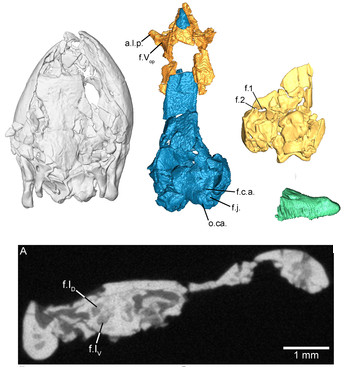Scintillating caecilian fossils spill new secrets
Most of us are pretty familiar with frogs and salamanders, but many outside the world of natural history buffs have not heard of the third major group of living amphibians, the caecilians. Caecilians (pronounced roughly like “Sicilians“) are truly odd little legless animals, looking more or less like a worm with tiny eyes. Most of them are burrowers, feeding on subterranean invertebrates. Caecilians are also characterized by unique cranial tentacles, and the young of at least some species feed on their (living) mother’s skin. These amphibians are truly an unusual group (well summarized by Darren Naish here and here).

As with many unusual groups of organisms, the fossil record for caecilians is pretty dismal. Few fossils are known, probably due to the fact that these animals have small and rather delicate skeletons. One fortunate exception is Eocaecilia micropodia, the oldest known caecilian. Eocaecilia was around 15 cm long and lived 190 million years ago (during the Early Jurassic) on what are now the lands of the Navajo Nation in northeastern Arizona. Fieldwork by scientists from Harvard’s Museum of Comparative Zoology and Museum of Northern Arizona uncovered 40 skulls and partial skeletons of this animal—a truly remarkable record! These fossils allowed an unprecedented snapshot of an early caecilian. Although many bony features of Eocaecilia match its modern relatives, others—such as the retention of tiny limbs—are transitional between the ancestral and modern anatomy.

Eocaecilia was introduced to the modern world in 1993 through a brief Nature article (paywall), with a comprehensive description following in 2007 (freely available PDF). Even with all of this research, the internal anatomy of the skull in Eocaecilia was not terribly well-known. Its braincase was tiny and full of little nooks and crannies that could not be readily seen even with the best efforts. As an additional problem, the evolutionary relationships of Eocaecilia had not been thoroughly tested in an analysis with enough other species to fully evaluate its position. In fact, the unique combination of features in this animal led at least one researcher to posit that Eocaecilia wasn’t a caecilian at all!
So, in order to better understand Eocaecilia, researchers needed a more comprehensive analysis of its evolutionary relationships, incorporating data on more species as well as more data on the braincase of Eocaecilia itself. In a new study published this week in PLOS ONE, a team of three scientists led by Hillary Maddin (in collaboration with Jason Anderson and the late Farish Jenkins) did just that. First, they performed a high-resolution CT (computed tomography) scan of a skull of Eocaecilia. A common technique in paleontology, these scans allowed the team to look inside the fossil at many previously-hidden details. The resulting data were then used to create three-dimensional digital reconstructions that visualized important features of the anatomy.

Using the new information, Maddin and her co-authors ran a cladistic analysis to determine the relationship of Eocaecilia to other amphibians. This analysis built upon several previously-published datasets, expanded to the monster size of 308 different features evaluated in each of 64 different amphibians and close amphibian relatives. The result? Eocaecilia was definitively identified as a caecilian, a hypothesis supported by 37 separate features of the skull and skeleton.

Eocaecilia has a beefy skull compared to modern caecilians. Additionally, the skull of Eocaecilia is completely roofed over on top like in early relatives of today’s amphibians, but the skull roof in the most “primitive” living caecilians is open (just like in frogs and salamanders). So, was this anatomy something that Eocaecilia evolved on its own, or did it retain ancestral characteristics that later caecilians lost? By analyzing the patterns of anatomical features across the evolutionary tree, Maddin and colleagues inferred that many of the unusual features of Eocaecilia, including the closed skull roof, documented the ancestral state for caecilians (and amphibians as a whole). Additional fossils are needed to more thoroughly test this hypothesis.
Certainly, the fossil record of caecilians still leaves much to be desired. It would be really nice to find more (and more complete) fossils, but new analyses like the one by Maddin and colleagues allow us to wring every drop of data out of the fossils in hand.
Reference
Maddin HC, Jenkins FA Jr, Anderson JS (2012) The braincase of Eocaecilia micropodia (Lissamphibia, Gymnophiona) and the origin of caecilians. PLOS ONE 7(12): e50743. doi:10.1371/journal.pone.0050743 [link]
[note: I am a volunteer editor at PLOS ONE, and handled the paper discussed in this post]
